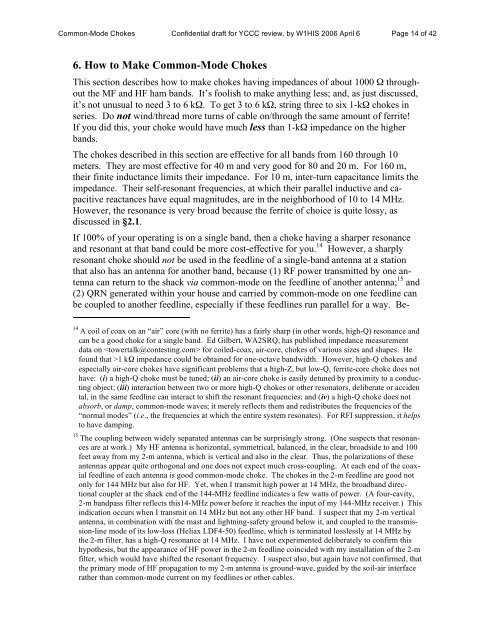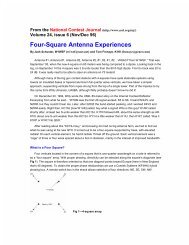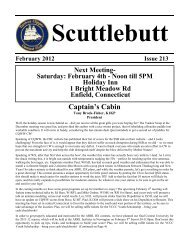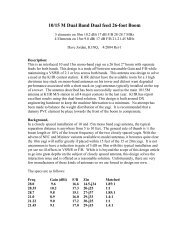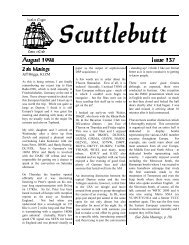Common Mode Chokes by W1HIS - Yankee Clipper Contest Club
Common Mode Chokes by W1HIS - Yankee Clipper Contest Club
Common Mode Chokes by W1HIS - Yankee Clipper Contest Club
You also want an ePaper? Increase the reach of your titles
YUMPU automatically turns print PDFs into web optimized ePapers that Google loves.
<strong>Common</strong>-<strong>Mode</strong> <strong>Chokes</strong> Confidential draft for YCCC review, <strong>by</strong> <strong>W1HIS</strong> 2006 April 6 Page 14 of 426. How to Make <strong>Common</strong>-<strong>Mode</strong> <strong>Chokes</strong>This section describes how to make chokes having impedances of about 1000 Ω throughoutthe MF and HF ham bands. It’s foolish to make anything less; and, as just discussed,it’s not unusual to need 3 to 6 kΩ. To get 3 to 6 kΩ, string three to six 1-kΩ chokes inseries. Do not wind/thread more turns of cable on/through the same amount of ferrite!If you did this, your choke would have much less than 1-kΩ impedance on the higherbands.The chokes described in this section are effective for all bands from 160 through 10meters. They are most effective for 40 m and very good for 80 and 20 m. For 160 m,their finite inductance limits their impedance. For 10 m, inter-turn capacitance limits theimpedance. Their self-resonant frequencies, at which their parallel inductive and capacitivereactances have equal magnitudes, are in the neighborhood of 10 to 14 MHz.However, the resonance is very broad because the ferrite of choice is quite lossy, asdiscussed in §2.1.If 100% of your operating is on a single band, then a choke having a sharper resonanceand resonant at that band could be more cost-effective for you. 14 However, a sharplyresonant choke should not be used in the feedline of a single-band antenna at a stationthat also has an antenna for another band, because (1) RF power transmitted <strong>by</strong> one antennacan return to the shack via common-mode on the feedline of another antenna; 15 and(2) QRN generated within your house and carried <strong>by</strong> common-mode on one feedline canbe coupled to another feedline, especially if these feedlines run parallel for a way. Be-14 A coil of coax on an “air” core (with no ferrite) has a fairly sharp (in other words, high-Q) resonance andcan be a good choke for a single band. Ed Gilbert, WA2SRQ, has published impedance measurementdata on for coiled-coax, air-core, chokes of various sizes and shapes. Hefound that >1 kΩ impedance could be obtained for one-octave bandwidth. However, high-Q chokes andespecially air-core chokes have significant problems that a high-Z, but low-Q, ferrite-core choke does nothave: (i) a high-Q choke must be tuned; (ii) an air-core choke is easily detuned <strong>by</strong> proximity to a conductingobject; (iii) interaction between two or more high-Q chokes or other resonators, deliberate or accidental, in the same feedline can interact to shift the resonant frequencies; and (iv) a high-Q choke does notabsorb, or damp, common-mode waves; it merely reflects them and redistributes the frequencies of the“normal modes” (i.e., the frequencies at which the entire system resonates). For RFI suppression, it helpsto have damping.15 The coupling between widely separated antennas can be surprisingly strong. (One suspects that resonancesare at work.) My HF antenna is horizontal, symmetrical, balanced, in the clear, broadside to and 100feet away from my 2-m antenna, which is vertical and also in the clear. Thus, the polarizations of theseantennas appear quite orthogonal and one does not expect much cross-coupling. At each end of the coaxialfeedline of each antenna is good common-mode choke. The chokes in the 2-m feedline are good notonly for 144 MHz but also for HF. Yet, when I transmit high power at 14 MHz, the broadband directionalcoupler at the shack end of the 144-MHz feedline indicates a few watts of power. (A four-cavity,2-m bandpass filter reflects this14-MHz power before it reaches the input of my 144-MHz receiver.) Thisindication occurs when I transmit on 14 MHz but not any other HF band. I suspect that my 2-m verticalantenna, in combination with the mast and lightning-safety ground below it, and coupled to the transmission-linemode of its low-loss (Heliax LDF4-50) feedline, which is terminated losslessly at 14 MHz <strong>by</strong>the 2-m filter, has a high-Q resonance at 14 MHz. I have not experimented deliberately to confirm thishypothesis, but the appearance of HF power in the 2-m feedline coincided with my installation of the 2-mfilter, which would have shifted the resonant frequency. I suspect also, but again have not confirmed, thatthe primary mode of HF propagation to my 2-m antenna is ground-wave, guided <strong>by</strong> the soil-air interfacerather than common-mode current on my feedlines or other cables.


